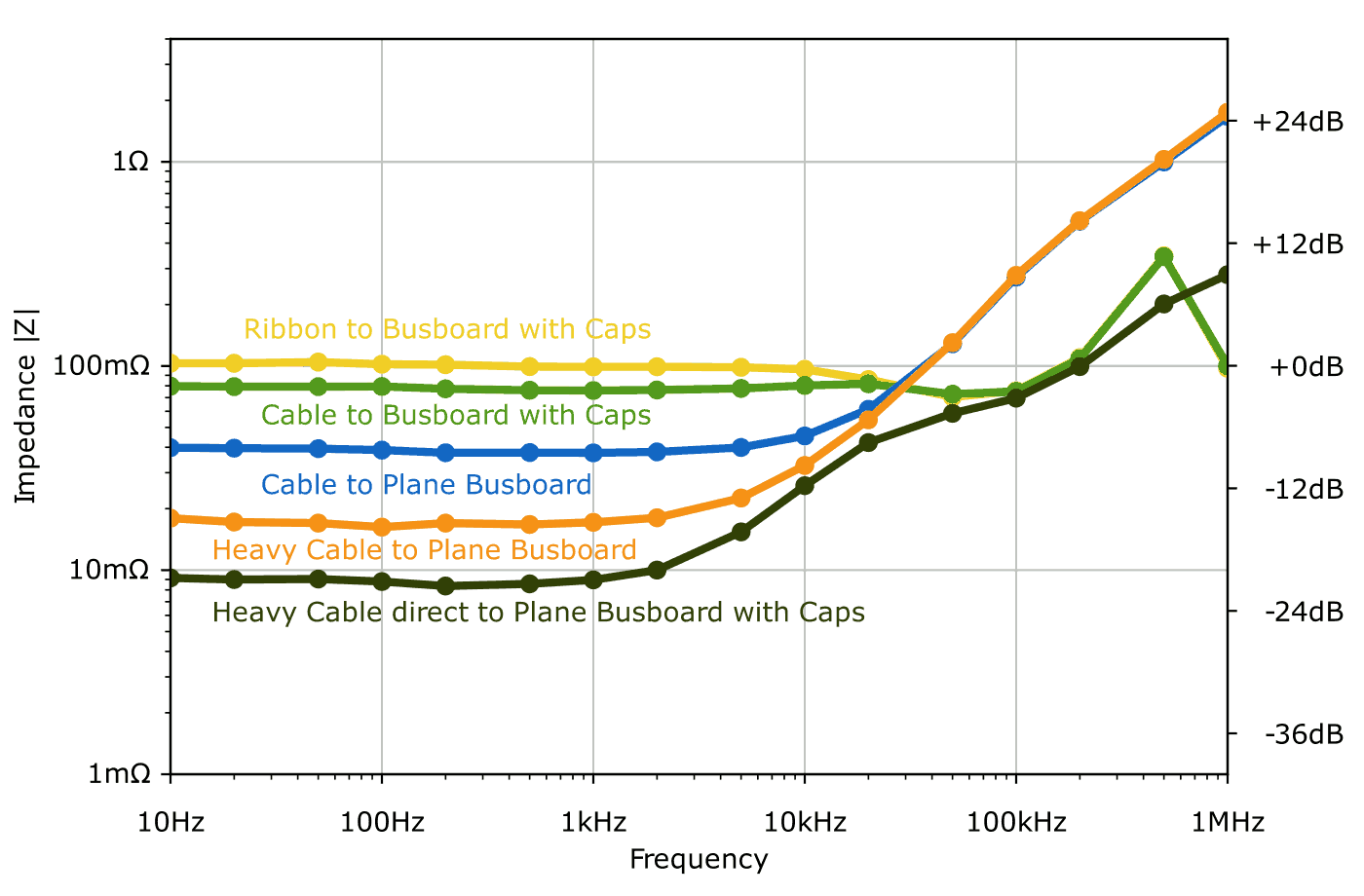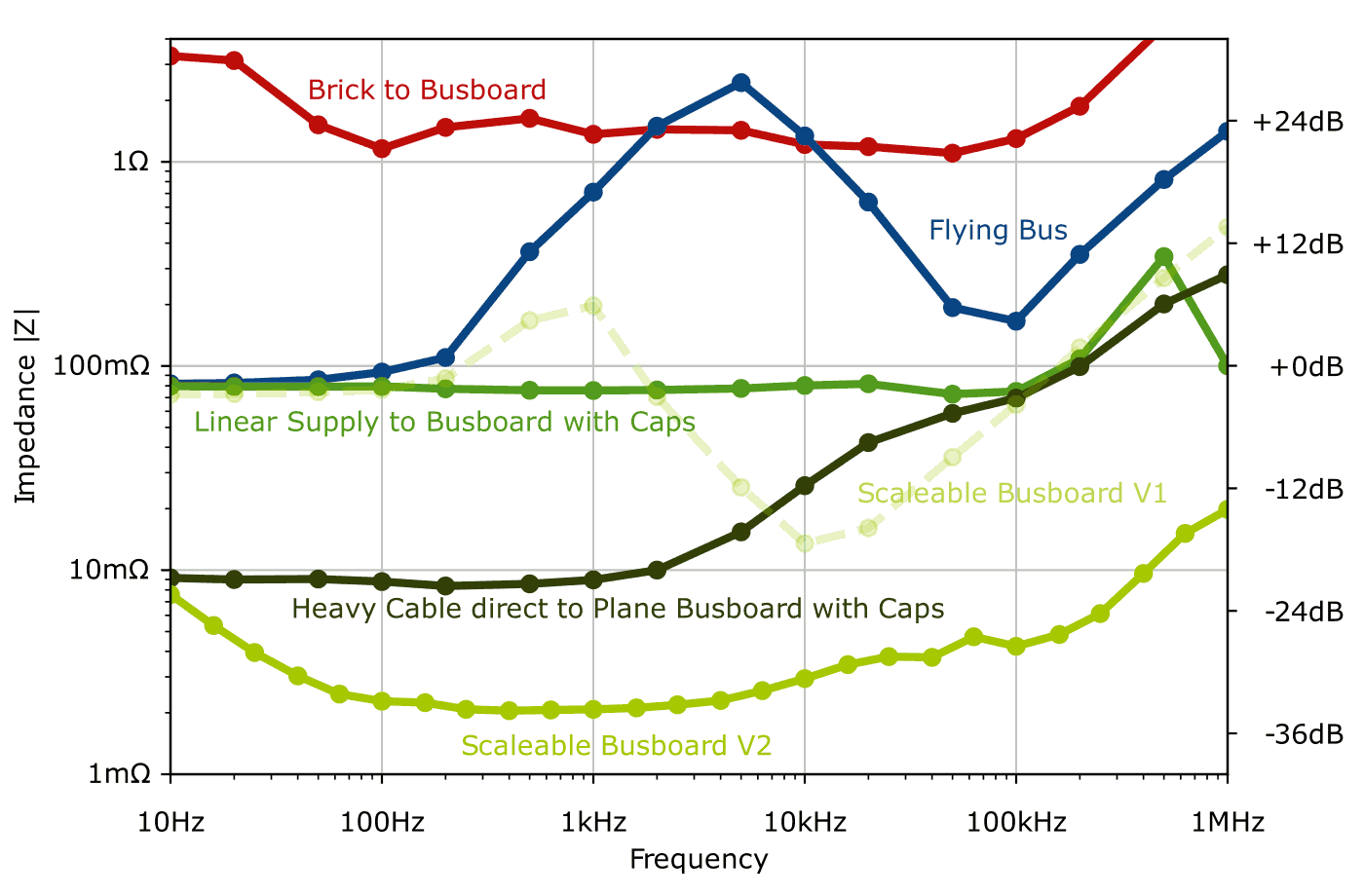Power Supply and Distribution Impedance
Eurorack power systems are comprised of several parts, the supply, cabling, and distribution. Any one of these could the be limiting factor in the overall performance and selecting a suitable combination can be difficult. One valuable piece of information rarely made available is the supply impedance, this can be provided for individual parts and combined for the estimated result or measured together as system. The impedance is a measure of how much the supply voltage will vary with changes in current (a form of resistance), this often varies with frequency so it is plotted across a useful range to see the overall picture. Ideally a power supply would not vary in its voltage at all and the impedance would be infinitely small but physical realities prevent that and some impedance will be present. All the measurements in this document were taken with a single bus connected by a short 150mm/6" cable to the power supply, and measured at the furthest header.

Worst performing was a power brick as the power supply, although showing lower impedance at lower frequencies across the audio range and above it was poorly effective in controlling the power supply voltage. Connecting a small power supply module to a flying bus board or pcb busboard with capacitors had similarly poor impedance in the audio range. Yet many users have such systems and do not notice any problems. This is because unlike noise in the 0V reference not all modules are equally sensitive to noise on the power supply rails, well designed modules actively reject this noise and minimise the varying currents they draw to avoid affecting other modules. Even if a module in the case is sensitive to power noise it requires another module to be varying the current draw for it to be heard. A common recommendation has been for users with problems to upgrade to a linear power supply and bus boards, an example of which is shown for comparison.
While switching supplies have received a bad reputation in the past for poor noise and output impedance control, output impedance of linear supplies can be similarly variable and high quality examples of switching supplies exist. That characteristic alone cannot be used to select a higher performing supply. Worse the output impedance of the supply can vary depending on the current or capacitive load connected such that adding or removing modules can make unexpected differences. This is why measuring the entire system is important rather than relying on estimates of the parts individually. Given a supply with poor control of output impedance simply adding better bus boards with more capacitance is not always enough:

Here the same supply as before is moved from a typical busboard connected with a ribbon cable to a large plane type busboard connected with a low resistance plug in cable that also had more capacitance on it. Still there is a large peak at the bottom of the audio range. Changing to a high quality linear power supply and using only the low resistance plug in cable both bus board types are significantly improved across the audio range. With a solid supply to start with the difference between boards with and without capacitance is only above the audible range. For more detail of this and the difference cabling choices make the measurements are repeated for different configurations connected to the same high quality linear power supply.

A typical bus board is not improved significantly by changing from using a ribbon cable to the low resistance plug in cable, its own resistance still dominates the result. With the plane type bus board differences from wiring is clearer, the ultimate example using a 150mm/6" length of heavy 12AWG cable soldered directly to the bus board. At these low resistances any connectors used affect the result with screw terminals adding milliohms or even 10 milliohms to the result. To go lower bolted ring terminals crimped to cables are usually needed to get connections below a milliohm. Large wires to match these low resistances can be impractical and busbars quickly become the easier solution for the lowest impedances, limited by the power supply they closely follow the lowest plot before rising similarly to the other examples without capacitors.
The linear power supply that can achieve this sort of performance at 10kg/25lbs is larger and heavier than many racks themselves. Many supplies advertise impressive load regulation specifications which are related to the impedance at extremely low frequencies approaching DC, but fail to maintain these figures up into the audio range even if using advanced features such as remote sensing. There are better and worse power supplies available than whats shown here but obtaining these figures before purchase is difficult, and then changes in a system in use.
Also, looking only at impedance is ignoring the the noise from the power supply itself which adds to the voltage variations seen by the modules. With typical noise performance of the best supplies at several mV this grows to 10's of mV for typical supplies to even 100mV or more in poor examples. Only with a starting noise performance of 1mV from the power supply would it be likely to hear power rail impedance differences of under 10 milliohms, with a more typical 10mV or 20mV of noise 0.1 ohms of impedance as seen in traditional systems is low enough that further reductions to the power rail impedance are unlikely to make noticeable differences. With the larger currents and higher sensitivity of the 0V distribution any changes should aim to improve that more than the power rails.
Comparing the extreme examples collected here in a single figure there is greater than a 100 to 1 difference.

Limited at audio frequencies by the power supply most systems would do better to replace their supply and/or distribution cabling ahead of the bus boards. But as a system grows the noise from additional modules connected to the same power supply adds together. A more effective way to isolate power noise is to have multiple power supplies in a system, several manufacturers offer active bus boards as a way to easily add many self contained power supplies to a system. The scaleable power system is an example of this along with its other features in an integrated and simple to use design.
